Учебное пособие Издательство Томского политехнического университета 2009
| Вид материала | Учебное пособие |
- Редакционно-издательским советом Томского политехнического университета Издательство, 1434.78kb.
- Редакционно-издательским советом Томского политехнического университета Издательство, 3189.24kb.
- Редакционно-издательским советом Томского политехнического университета Издательство, 2424.52kb.
- Редакционно-издательским советом Томского политехнического университета Издательство, 2585.19kb.
- Редакционно-издательским советом Томского политехнического университета Издательство, 1488.99kb.
- Учебное пособие подготовлено на кафедре философии Томского политехнического университета, 1526.78kb.
- Учебное пособие Издательство Томского политехнического университета Томск 2007, 1320kb.
- Учебное пособие Рекомендовано в качестве учебного пособия Редакционно-издательским, 2331.42kb.
- М. В. Иванова Томск: Издательство Томского политехнического университета, 2008. 177, 2610.26kb.
- Я управления рисками в организации рекомендовано в качестве учебного пособия Редакционно-издательским, 1160.94kb.
Social English
Expressing likes
I like … very much indeed
I (really) enjoy …
I’ve always liked/ loved
There is nothing I like/enjoy more than…
I’m really very fond of…
…is really terrific/great, etc
It’s too lovely for words
It’s awesome!
I’d like to point out
Expressing dislikes
(I am afraid) I don’t like …
I’ve never liked…, I’m afraid
…is not one of my favourite…
I really hate …
I think… is pretty awful/really unpleasant
I’m not (really) very keen on…
… is ghastly/ rubbish
I can’t say… appeals to me very much
I must say, I’m not too fond of …
Expressing Indifference
I can’t say I am interested
I am sorry to disagree with you
The whole thing bores me to death
I couldn’t care less
I don’t mind what you say (do)
Expressions to remember
What a dull picture!
Why there is no colour in it?
Each to your own opinion, dear.
I hate it like hell.
For me it’s just phoney
Isn’t that lovely?
I did like it. I haven’t seen a picture for years I have liked so much.
I think that one’s got something
Some more general phrases, characterising a picture
- This delightful picture reveals… - Эта восхитительная картина раскрывает…
- The magnificent setting in the background enhaces the beauty of this priceless work – Величественный фон на заднем плане усиливает красоту этой бесценной работы
- The scene crackles with energy – энергия бьет ключом в этой картине
- The whole picture is permeated with the subtle charm - Картина пронизана тонким очарованием
- It proves the painter’s perfecr mastery – Она доказывак совершенное мастерство жудожника
- The picture is executed with infinite skill - Картина выполнена с отменным мастерством.
- It’s an exquisite gem of the Renaissance – Это изысканная жемчужина Ренессанса (gem – драгоценный камень, жемчужина)
- The background could also be a piece of genre painting - Задний план также может быть образцом жанровой живописи
- The picture belongs to the artist’s maturity style and is considered as one of his best. – Эта картина принадлежит к зрелому периоду творчества художника и считается одной из его лучших картин.
10. It ranks among the masterpieces of world painting - Oна считается одним из мировых шедевров живописи.
Pair-wok
Task 3 . Work with your partner
Express your feelings about the following subjects. Use the clichés of likes and dislikes and explain why you think so.
6. Snapshots from a family album 7. A guided tour of a museum. 8. Impressionism 9. Vanguard 10. Animals in art. | |
2.1. Understanding Icons
Icon painting appeared not as art for art's sake, but for the Church. Thus, its content was determined directly by the needs and the purposes of the Church. These purposes were not material but spiritual. The faith of the Church defined from the beginning the content and character of icon painting. The Church was primarily interested in the beauty of this spiritual world and, with the means it possessed; it tried to interpret that world. It did not try to depict the natural good and beauty. The purpose and the ideal of Byzantine icon painting was the expression of the category of holiness, which was not made to appeal to the senses by being physically beautiful. In Christian Orthodox art the beautiful is not determined by the natural form of the objects, but by its sublime content, that is, by its power to serve the ideals of the faith.
These basic ideas of Orthodox icon painting are the main obstacles to our appreciation of icons. When we look at icons, we are struck by their apparent simplicity, by their overemphasized flatness, unreal colors, lack of perspective, and strange proportions. At that moment we should stop and remind ourselves that we are applying to icon painting those aesthetic criteria which allow us to enjoy the works of the Italian masters of the Renaissance. As viewers, we apply the familiar criteria to an unfamiliar artistic expression. In a word, we are used to see on the surface of a canvas or panel something familiar, easily recognizable, something which we can adequately analyze by using familiar categories of perspective, color scheme, point of view, light and shadow, and volume.
Unfortunately, we cannot use this kind of analysis on icon painting because, in contrast to the art of the Renaissance, icon painting is not illusionist, that is, it does not try to convince the viewer that the world depicted on the panel is real, but, on the contrary, tries to make sure by all the means it possesses, that the represented is unreal, ideal, dematerialized. We cannot diminish the achievements of Byzantine and Russian artists by assuming that they did not know how to paint better. They simply consciously and purposely employed a completely different convention of painting, a completely different artistic language. To be able to appreciate the spiritual depth of icon painting we must learn at least the basic "grammar" of t
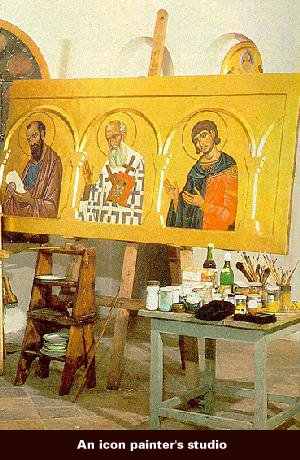 his language.
his language. Icon painting strikes us by the frontality of the figures. This frontality brings the figures in direct relationship with the viewer and gives the fullest expression to the faces.
The faces of the saints have large, almond-shaped eyes, enlarged ears, long thin noses, and small mouths. Icon painters attempt to indicate that each sensory organ, having received the Divine Grace, was sanctified and had ceased to be the usual sensory organ of a biological man.
Icon painting deliberately disregards the principle of natural perspective in order to avoid at any cost the illusion of three-dimensionality. Instead, it gives the impression of complete flatness and the lack of perspective.
Icon painting uses the so-called psychological perspective which is based on the principle that the most important figure in the composition should be the largest and centrally placed. The viewer's attention is drawn to what is central and larger rather than to what is marginal and small.
Since icon painting is not realistic, it shows no natural source of light and does not represent shadows. The only light in icons is the inner light of sacred figures and the divine light of Christ.
Icon painting has the ability to represent several moments of the same action (story) on one panel. In the scene of the Nativity we can see not only the birth itself, but also the arrival of the Magi, the shepherds spreading the good news, Joseph being tempted by the devil, and even the servant women washing the baby. Some scholars call this the "continuous style."
Other features of icons which help us in understanding their meaning are simplicity, clarity, measure or restraint, grace, symmetry or balance,
appropriateness and symbolic colors.
Vocabulary
Orthodox - православный
art for art’s sake - искусство ради искусства
spiritual - духовный
faith - вера
holiness - святость / holy - святой
sublime content - высокое, возвышенное содержание
overemphasized flatness – подчеркнутая, преувеличенная плоскость (изображения)
flat - плоский
illusionist - создающий иллюзии, обманчивый
to diminish – уменьшать, ослаблять
the Divine Grace – Божественная Милость, Благословение
to sanctify - освящать
the illusion of three-dimensionality – эффект трехмерности
marginal - находящийся с краю
sacred figures - святые фигуры
the Nativity - Рождество Христово
the Magi - волхвы
the shepherds - пастухи
to tempt - соблазнять
restraint - сдержанность
appropriate - подходящий, соответствующий
Task 4. Chose the answer (a, b, c) which you think fits best according to the text
1. The content of icon painting is determined by the
- needs of the church
- material purposes
- cultural needs
2. The ideal of Byzantine icon painting was the expression of
a) the category of holiness
b) physical beauty
c) the inner world
- When we look at icons we should apply
- aesthetic criteria of the Renaissance
- the familiar criteria to the unfamiliar artistic expression
- other criteria
4. Icon painting tries to convince that the world depicted on the panel is
a) real
b) unreal
c) familiar
5. To appreciate the spiritual depth of icon painting we must learn
a) the Basic Language Grammar
b) the Basic Russian Grammar
c) the basic icon painting laws
6. The principle of natural perspective
- creates the illusion of three-dimensionality
- destroys the illusion of three- dimensionality
- gives the impression of complete flatness
- The psychological perspective of icons is based on the principle
- that the viewer’s attention is drawn to what is marginal
- that the most important figure is to be placed at the bottom
- that the viewer’s attention is drawn to what is central
8. The only light in icons is from
a) natural sources of energy
b) artificial sources of light
c) inner light of sacred figures
2.2. Andrei Rublev (1370-1430)
Born in a period of monastic revival, Rublev grew up in the period of increased public trust and support for the Eastern Orthodox Church. Although little is known about his life, sufficient evidence is available to begin to understand his work and the religious convictions that inspired it. Rublev is best known for his masterpiece “The Old Testament Trinity”. This icon exemplifies the simplicity and the skill of his style, as well as its ability to transcend pictorial constraints with spiritual and religious ideas. Renowned for its lyrical and rhythmic quality, the icon was an instant success and found many imitators. Perhaps Rublev contributed the most to icon painting. The icon “The Annunciation” (14th century) represents the moment when "The angel came in unto (Mary), and said, Hail, thou that art highly favored, the Lord is with thee, blessed art thou among women. And when she saw him, she was troubled at his saying, and cast in her mind what manner of salutation this should be. And the angel said unto her, Fear not, Mary: for thou hast found favor with God. And, behold, thou shalt conceive in thy womb, and bring forth a son, and shalt call his name JESUS." (KJV, Luke 1: 28-31).
In this painting the artist faithfully expresses the emotion and importance of the Annunciation scene. The angel occupies the left half of the picture plane, Mary occupies the right, and both stand out against the background constructed of architectural details connected in the middle of the picture. In contrast to the rather flat, forward–facing figures found in some icons, the announcing angel is shown from a side v
 iew which emphasizes depth and dynamic movement. The flow of drapery and the position of the wings reflect the fact that the angel has suddenly appeared and help strengthen the contrast with Mary, who is shown in a fixed and motionless pose. The beautiful gold and blue-green of the angel also emphasizes its heavenly origin and is balanced by the dark clothing worn by Mary, a rep
iew which emphasizes depth and dynamic movement. The flow of drapery and the position of the wings reflect the fact that the angel has suddenly appeared and help strengthen the contrast with Mary, who is shown in a fixed and motionless pose. The beautiful gold and blue-green of the angel also emphasizes its heavenly origin and is balanced by the dark clothing worn by Mary, a representative of earth and humankind.
While the angel's hand is outstretched as the messenger speaks God's message, Mary's head is bowed as if in agreement and humility. Both figures are well-proportioned and accurately express the content of the scene.
The Annunciation
The overall color scheme of the background consists of a combination of yellow, cream, shades of orange, and black, which give the icon a warm tone. The two figures in the foreground stand out against the surrounding colors, but do not clash with them. In fact, Mary's clothing seems to correspond to the dark colors found in the roofs above her and in the angel, helping to unite foreground and background. The angel's coloring emphasizes its heavenly nature. He functions as one who announces the will of God to the world.
The Annunciation theme had been well established in icon painting and could be traced, like many other themes, to the traditional Byzantine prototypes. One of the most admired icons of this type, “ The Annunciation of Ustyug” (Novgorod, 1110-30, shown on t
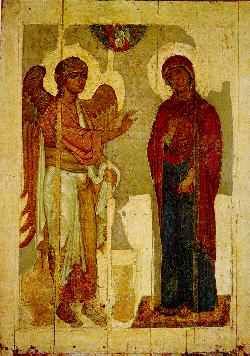 he right) demonstrates how closely the early Russian icons preserved the Byzantine heritage, while infusing it with a new Russian style. In this Annunciation the composition is more monumental than in its 14th century Muscovite version. The Angel and Mary are strong, uncompromising figures who seem to speak directly to the viewer; here the impact is immediate and forceful. While the figures may lack some of the later icon's movement, they are, nevertheless, equally impressive in their monumentality and spirituality. The angel seems to resemble ancient statues, and its facial features, hair, and the flowing garments make us think of classical antiquity.
he right) demonstrates how closely the early Russian icons preserved the Byzantine heritage, while infusing it with a new Russian style. In this Annunciation the composition is more monumental than in its 14th century Muscovite version. The Angel and Mary are strong, uncompromising figures who seem to speak directly to the viewer; here the impact is immediate and forceful. While the figures may lack some of the later icon's movement, they are, nevertheless, equally impressive in their monumentality and spirituality. The angel seems to resemble ancient statues, and its facial features, hair, and the flowing garments make us think of classical antiquity. The Annunciation of Ustyug
Notes
1. Old Testament - Ветхий Завет
2. The Annunciation - Благовещение
3. monastic revival - возрождение монашества, монастырей
Task 5. Look at the painting “The Last supper”, find the characters described, read and render the text in English.
“Тайная вечеря” — самое зрелое и законченное произведение Леонардо. В этой росписи мастер избегает всего того, что могло бы затемнить основной ход изображенного им действия, он добивается редкой убедительности композиционного решения. В центре он помещает фигуру Христа, выделяя ее просветом двери. Апостолов он сознательно отодвигает от Христа, чтобы еще более акцентировать его место в композиции. Наконец, в этих же целях он заставляет сходиться все перспективные линии в точке, непосредственно расположенной над головой Христа. Учеников Леонардо разбивает на четыре симметрические группы, полные жизни и движения. Стол он делает небольшим, а трапезную — строгой и простой. Это дает ему возможность сосредоточить внимание зрителя на фигурах, обладающих огромной пластической силой. Во всех этих приемах сказывается глубокая целеустремленность творческого замысла, в котором все взвешено и учтено..."
“ Тайная вечеря: мягкий, обреченный жест учителя. Кротость, с которой произнесены страшные слова о предательстве, – троих из 12, поразили, словно гром среди ясного неба. Невозможность постичь случившееся, неприятие зла отразились на их лицах (слева). Трое других (справа) страстно и безответно вопрошают друг друга: “Который же из нас”? Недоуменно и растерянно, с немым вопросом вскочил Филипп – но ничего более не сказал ему Учитель. Развел руками возмущенный Яков. Фома застыл с поднятою рукою. Негодующий Петр схватился за нож, требуя указать злодея, но взгляд его задержался на безвольно поникшей фигуре Иоанна – последний во всем стремился подражать Учителю, разве что у того кротость – это глубокая мудрость, а у юноши – слабость. И порыв Петра как бы гаснет, хотя виновник рядом – резко о
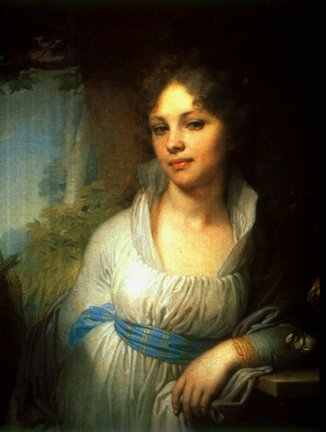 тпрянул от Учителя, зажав в руке свои серебренники: никто не обращает на него внимания, а ведь страх уже выдал его с головой, - поза, полная ужаса, выражение лица, заметная оттчужденность от остальных не оставляет сомнений”.
тпрянул от Учителя, зажав в руке свои серебренники: никто не обращает на него внимания, а ведь страх уже выдал его с головой, - поза, полная ужаса, выражение лица, заметная оттчужденность от остальных не оставляет сомнений”.2.3. Vladimir Lukich Borovikovskii: “Portrait of Madame Lopukhina” (1797).
This portrait is one of the most famous Russian paintings of the 18th century. Every aspect of it is carefully controlled and directed to produce a certain effect, to create an atmosphere that is both in accord with, and slightly differing from, the prevailing neoclassical style of the day. This is reflected in the subtle natural background, the classic simplicity of Madame Lopukhina's dress, and the cool sense of decorum, individual calm, and quiet assurance that is transmitted through the combined effect of these and other details. At the same time, Madame Lopukhina's image reflects many characteristics of Borovikovskii's style that depart from standard neoclassical practice. This portrait, for instance, is far less ceremonial than many that were produced at the time. Madame Lopukhina is not decked out in her finest clothing, she is not depicted among rich surroundings, neither is she stiff and artificially posed. Rather, she is dressed unostentatiously and placed in an obscure natural background, which while it conforms to the neoclassical idea of nature's secondary position, contrasts with the formality often associated with neoclassic 'symbolic' portraits. Her pose, too, though it may not be natural, at least seems to be so. The "languid" position of her body, her facial expression, the tilt of her head, all combine to create a sense of individual character. Madame Lopukhina is here at ease, in her natural state of mind and a psychologically revealing pose. Her gaze is familiar, her eyes expectant, her mouth bantering, while her posture indicates a relaxed, confident poise (осанка, посадка головы).
One of the most noticeable elements of Borovikovskii's technique in this painting, which contrasts with common neoclassical practice and some of of his other works, is the soft-focus nature of the portrait. Even more obvious is his delicate use of color to create a harmonious atmosphere in which, again, Madame Lopukhina's presence is a natural occurrence. The cool tones of the background, her dress, and her sash are softly contrasted with the warmer tones of her face and neck. Though aesthetically pleasing on its own, the color scheme has a more important place in this portrait, accentuating her figure through an elegant luminescence that is only heightened by the dimming of the corners. Together these elements may create a slightly 'sentimental' portrait, but one that is nevertheless effective, and testifies to Borovikovskii's skill and importance as an 18th century Russian painter. At the same time, it reflects the "elegance" typical of the best 18th century Russian painting and supports the idea that Borovikovskii "was at heart a realist who never failed . . . to create a likeness"
“Портрет Е.А.Нарышкиной” (1799)
Портрет Елены Александровны Нарышкиной (1785–1855) – один из лучших женских портретов, написанных Боровиковским в конце XVIII века. Нарышкина – дочь обер-камергера А.Л.Нарышкина. В первом браке она была замужем за сын
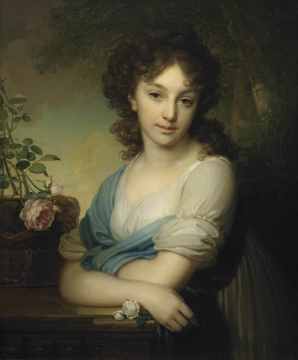 ом генералиссимуса А.В.Суворова графом А.А.Суворовым-Рымникским; овдовев, вышла вторично замуж за князя В.С.Голицына. Е.А.Нарышкина обладала хорошими музыкальными способностями. Итальянский композитор Дж. Россини написал в ее честь кантату. Она была дружна с поэтами В.А.Жуковским и И.И.Козловым. Художник изобразил еще юную очаровательную девушку, с томной улыбкой взирающую на зрителя. Героиня одета в изысканно-скромное платье, по плечам небрежно рассыпались кудри. В портрете ощущается влияние эстетики позднего классицизма – четкий рисунок, определенность контуров, колорит, тяготеющий к локальным цветам.
ом генералиссимуса А.В.Суворова графом А.А.Суворовым-Рымникским; овдовев, вышла вторично замуж за князя В.С.Голицына. Е.А.Нарышкина обладала хорошими музыкальными способностями. Итальянский композитор Дж. Россини написал в ее честь кантату. Она была дружна с поэтами В.А.Жуковским и И.И.Козловым. Художник изобразил еще юную очаровательную девушку, с томной улыбкой взирающую на зрителя. Героиня одета в изысканно-скромное платье, по плечам небрежно рассыпались кудри. В портрете ощущается влияние эстетики позднего классицизма – четкий рисунок, определенность контуров, колорит, тяготеющий к локальным цветам.2.4. Karl Pavlovich Bryullov (1799-1852)
When Bryullov was born in 1799, the Neoclassical style in Russia still reigned, but the period of its greatest productivity and popularity was over.

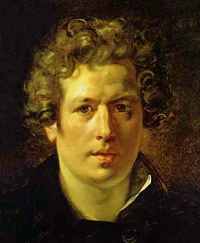
Bryullov Karl: Self-Portrait Bryullov K. Italian Midday 1827
Perhaps this influenced Briullov's early distaste for the return to classicism; at any rate, despite his education at the St.Petersburg Academy of Arts (1809-1821), Bryullov never fully embraced the style taught by the Academy. After distinguishing himself as a promising and imaginative student and finishing his education, he left Russia for Rome. Here he worked until 1835 as a portraitist and genre painter, though his fame as an artist came when he got involved in historical painting. His most famous work, “The Last Day of Pompeii” (1830-1833), created a sensation of Italy and established Bryullov as one of the finest painters of his day.
The topic is classical, but his dramatic treatment and generous use of chiaroscuro render it somewhat farther advanced from the neoclassical style. In fact, “The Last Day of Pompeii” exemplifies many of the characteristics of romanticism as it manifests itself in Russian art, including drama, realism tempered with idealism, increased interest in nature, and a zealous fondness for historical subjects. According to Hamilton, Sir Walter Scott is reported to have looked at the painting for an hour and declared afterwards that it "wasn't a painting, but an epic". Although by today's standards we may find the painting somewhat theatrical and lacking in life, it is certainly an important achievement for an artist in the early nineteenth century, and a significant step in the development of historical painting in Russia.
Soon after “The Last Day of Pompeii”, Bryullov returned to Russia , where he was joyously received. While teaching at the Academy (1836-1848) he continued his own artistic efforts, but was unable to produce a work comparable to his "masterpiece." His portrait painting, however, was more successful, at least in retrospect. His portrait style combined a neoclassical simplicity with a romantic tendency that fused well, and his penchant for realism was satisfied with an intriguing level of psychological penetration. A transitional figure between Russian neoclassicism and romanticism, Bryullov may be considered the first Russian artist of international fame
Some other Brulov’s pictures are: “Rider” (1832), “Bahchisaraiskiy Fountain”, “Portrait of Sisters Alexandra and Olga Shishmarevy” (1839), etc.
zealous – рьяный, усердный
Translation Practice.
Карл Павлович Брюллов - русский живописец, профессор Петербургской академии художеств (с1836 г.), почётный член Миланской, Болонской, Флорентийской, Пармской академий. Учился у отца, академика орнаментальной скульптуры, в академии художеств. В 1823-1834 гг. Брюллов жил в Италии, создал ряд жанровых картин ("Итальянское утро", "Итальянский полдень"), в которых решал проблемы осветления, показывал взаимосвязь человека с природой. Черты романтизма имеют автопортрет, портреты Брюллова, Г.Гагарина и одна из лучших работ - "Всадница". Широко известно полотно "Последний день Помпеи" (1830-1833 гг., золотая медаль в Париже). Трагическая гибель людей во время извержения Везувия, поэтика чувств, величие человеческого духа перед слепой стихией иллюстрировали драматическое восприятие художником жизни.
С 1843 г. Брюллов более четырех лет расписывал Исаакиевский собор. Главное достижение этого времени - портреты деятелей русской культуры (Кукольника, Витали, Жуковского, Крылова). В 1849 г. из-за болезни уехал на остров Мадейру, в 1850 г. переехал в Рим, там написал портреты архитектора Ланчи и членов семьи Титони. Творчество Брюллова - одна из вершин русской живописи 30-40-х гг. 19 века. В искусство классицизма он внёс жизненность и непосредственность. Реализм его произведений имел преимущественно романтическую окраску. Последние годы жизни постоянно жил в Италии, с которой Брюллова связывала близкая дружба.
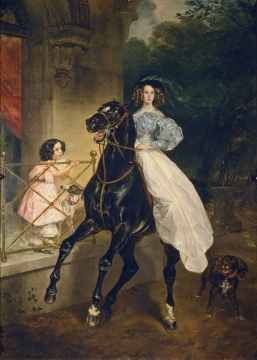 В картине “Всадница” важно не столько повествование, сколько действие. Старшая из сестер резко останавливает разгоряченного коня, но сама остается абсолютно спокойной. Дикая сила, покоряющаяся хрупкой красоте, – один из излюбленных мотивов романтизма. Лицо девушки идеально прекрасно. Итальянский тип внешности считался во времена Брюллова совершенным, и художник с удовольствием его обыгрывает. Изысканные переливы красок, искрящиеся ткани – каждая деталь словно провозглашает великолепие этого полотна.
В картине “Всадница” важно не столько повествование, сколько действие. Старшая из сестер резко останавливает разгоряченного коня, но сама остается абсолютно спокойной. Дикая сила, покоряющаяся хрупкой красоте, – один из излюбленных мотивов романтизма. Лицо девушки идеально прекрасно. Итальянский тип внешности считался во времена Брюллова совершенным, и художник с удовольствием его обыгрывает. Изысканные переливы красок, искрящиеся ткани – каждая деталь словно провозглашает великолепие этого полотна.К. Брюллов. Всадница,1832
Изображены сестры Джованнина и Амацилия Пачини, воспитанницы
графини Ю.П.Самойловой
2.5. Ivan Constantinovich Aivasovsky (1817 - 1900)
The Black Sea has always been an inspiration to artists, and if there was one man who devoted his life to expressing its beauty through his brushes, it was Ivan Aivasovsky. The majority of his paintings were seascapes, distinguished by his skilful use of light to bring the waves alive.
Aivasovsky was born in 1817 in Feodosia - originally the Greek settlement of Theodosia - at the eastern end of the Crimean coast. His father was an Armenian merchant and his mother a skilled embroiderer, but at the time young Ivan was born the port was still recovering from the economic downturn caused by the plague in 1812, and the family were not at all well off. The young boy grew up in a town which was a colourful mix of Greeks, Russians, Armenians, Turks and Tatars, all trying to scratch a living and he probably had to work to help the family out from an early age. He quickly developed an aptitude for music and art, but had no money for paper and instead sketched in charcoal on the white walls of houses.
Eventually his talent came to the attention of the governor of Feodosia, A. I. Kaznacheev, who placed the boy at school in Simferopol and later successfully petitioned the Academy of Arts in St Petersburg for a place for him. Aivasovsky did well at the Academy. On completing his studies he was awarded a travelling scholarship, but with the unusual condition that he should first spend two summers in Crimea perfecting his painting from nature. This he did, and his letters at the time are full of enthusiasm for the inspiration he found in the Crimean landscape. After his two years in Crimea, Aivasovsky toured Europe and fell in love with the southern Italian coast. He produced more than 20 paintings around the Bay of Naples and the Amalfi coast, making the acquaintance of the Russian painter Ivanov, who was living in Rome at the time. Ivanov recognised his talent, commenting that "nobody here paints water like he does..."
By his late twenties Aivasovsky had already made his name as far as painting was concerned. Pope Gregory XVI bought his Chaos (the Creation of the World) for the Vatican museum. The English landscape painter Joseph Turner was so struck by his picture The Bay of Naples on a Moonlit Night that he wrote him a short poem in Italian praising its genius. When he was not yet 30 he returned to Russia to become a professor at the St Petersburg Academy, breaking his journey in Amsterdam to hold an exhibition and to be elected to the Amsterdam Academy too. Aivasovsky did not make his permanent home in St Petersburg, preferring to return to live in Feodosia where he had grown up. Here he set up his studio and founded an art school.
He made a point of only painting from memory, allowing his imagination to influence the image on canvas. Aivasovsky felt strongly that "an artist who only copies from nature becomes her slave...The motion of the living elements is too elusive for the artist's brush: it would be senseless to try to paint a flash of lightning, a gust of wind or the splash of a wave from nature... The painter must remember them... The subject of a painting takes shape in my memory like the subject of a poem takes shape in a poet's: having made a sketch on a scrap of paper I set to work and I only leave the canvas when I'm happy that my brush has expressed what is in my mind."
The gallery in Feodosia. Aivasovsky founded the gallery himself and left it to the town when he died in 1900. It has over 400 of his paintings and sketches, as well as photographs and memorabilia, and paintings by other artists such as Viloshin, Lagorio, Vessler and Bogayevsky. Some of Aivasovsky's canvasses are huge, reaching almost from floor to ceiling of the large exhibition rooms, and their size adds to the sense of the overwhelming power and beauty of the sea that they convey so effectively. Fyodor Dostoevsky, a great admirer of his painting “Storm” said "it has ecstasy, that eternal beauty which so strikes the spectator in a living, real storm".
The concept of light is all important to Aivazovskiy. The perceptive viewer will observe that while painting the waves, clouds or sky space, the artist's emphasis is on the light. In Aivazovskiy's art light is the eternal symbol for life, hope and faith.
The gallery has many of Aivasovsky's best known works, including his great masterpiece “Amid the Waves”, painted when he was 81 years old. By this time he was able to paint waves with a translucent quality which gave them extraordinary life and movement.
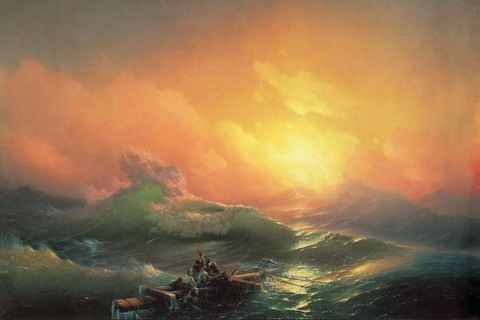
“Девятый вал”, 1850.
“ Девятый вал”.
В России - это одно из любимейших произведений отечественной живописи, растиражированное в миллионах (если не миллиардах) экземпляров репродукций. Причем огромная популярность пришла к нему сразу же после его первого показа широкой публике, состоявшегося осенью 1850 года в Московском училище живописи, ваяния и зодчества. Поток людей, желавших тогда взглянуть на "Девятый вал", не иссякал, многие ходили смотреть его по несколько раз, и это чем-то напоминало случившееся шестнадцатью годами раньше паломничество к "Последнему дню Помпеи" Брюллова. Вообще, Брюллова не случайно записывают в прямые учителя Айвазовского, хотя в Академии последний посещал совсем другую мастерскую. Многое роднит этот шедевр с брюлловской "Помпеей" - обе эти картины явили собой высший расцвет романтизма в русском изобразительном искусстве. Вскоре пришли другие времена, когда "страсти роковые" перестали пользоваться популярностью, уступив место "правде жизни". Айвазовскому немало досталось от новейшей критики, но даже ее апологет, В. Стасов, неизменно признавал, что "маринист Айвазовский по рождению и по натуре своей был художник совершенно исключительный". Не однажды предпринимались попытки истолковать "Девятый вал" как политическую аллегорию. При этом вспоминалась и волна революций, в 1848 году пронесшаяся над Европой, и общее "похолодание" российской жизни в конце 1840-х годов, и безвременная смерть Белинского, с большой симпатией относившегося к творчеству Айвазовского, и итальянские события... Впрочем, все было шито белыми нитками, и автор "Девятого вала" к этим построениям, по большому счету, не имеет никакого отношения.
Он не играл в аллегорические игры, а просто был влюблен в стихию, в шторм, в бурю. Морскую бурю он - человек, всю жизнь проживший рядом с морем, - знал не понаслышке. Любопытно одно признание живописца. В 1844 году корабль, на котором он плыл из Англии в Испанию, попал в страшный шторм - после этого в европейской прессе появились сообщения о гибели к тому времени уже прославившегося художника. К счастью, эти сведения оказались ошибочными. Впрочем, поволноваться пассажирам судна действительно пришлось немало. Многие обезумели от страха - но не Айвазовский: в нем, по его собственному признанию, "страх не подавил способности воспринять и сохранить в памяти впечатление, произведенное бурею, как дивною живою картиною". "Девятый вал" представляет собой типичное романтическое противопоставление "Человека" и "Стихии". Последняя страшна своей неразумной силой, но вместе с тем прекрасна.
“ Черное море”.
За внешним реализмом этого полотна скрывается глубочайшая метафизика. "Море" и "небо" - вот два главных его героя. Сюжет - их противоборство и единство. "Черное море" отличает какой-то неотменимый ритм, отвечающий вечному размеренному дыханию мира и внешне проявляющийся в ритмически сменяющих друг друга волнах. Художник впервые показал картину (на выставке в Академии художеств) под несколько другим - повествовательным! - названием: “На Черном море начинает разыгрываться буря”. Позже он исключил повествователъностъ, сократив название до точного и емкого “Черного моря” и подчеркнув тем самым стремление представить в картине реалистический и вместе с тем предельно обобщенный образ морской стихии. Большим поклонником этого произведения был И. Крамской - он даже включил его в собственную известную картину “Неутешное горе”, поместив за спиной героини и сделав своеобразным “зеркалом” ее душевных переживаний. У Айвазовского, отмечал Крамской, "есть вещи феноменальные - например, “Море”. Это одна из самых грандиозных картин, какие я только знаю".
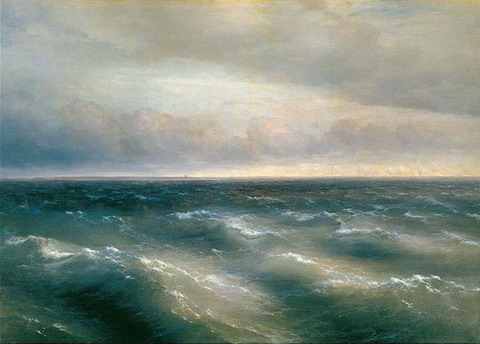
Айвазовский И.К. “Черное море”, 1881г.
2.6. Vasilii Andreevich Tropinin: “The Lace Maker” (1823).
 Like Orest Kiprenskii, Vasilii Tropinin was one of the first Russian artists to make the transition from the calm logic and propriety of neoclassicism to the warmth and emotion of romanticism. His portrait entitled “The Lace Maker “shows this transition simply in the choice of subject; instead of portraying a woman of the upper class and nobility, Tropinin chooses to paint a “common” woman engaged in work. As would become popular in romantic painting, an everyday subject was chosen and portrayed in an almost idealized light. However, the lace maker appears too genuine and modest to be considered over-romanticized or over-idealized.
Like Orest Kiprenskii, Vasilii Tropinin was one of the first Russian artists to make the transition from the calm logic and propriety of neoclassicism to the warmth and emotion of romanticism. His portrait entitled “The Lace Maker “shows this transition simply in the choice of subject; instead of portraying a woman of the upper class and nobility, Tropinin chooses to paint a “common” woman engaged in work. As would become popular in romantic painting, an everyday subject was chosen and portrayed in an almost idealized light. However, the lace maker appears too genuine and modest to be considered over-romanticized or over-idealized.The light coming from the upper right hand corner creates a delicate, soft chiaroscuro resembling the soft rays of sunlight illuminating the lace maker's work. The background is clear and plain, which leads the viewer to focus more fully on the young woman and her tools. Since symbols were an important part of creating and defining character in neoclassical portraits, the work tools gathered around the young woman emphasize her trade and show her in an environment that is unique to her profession. As if interrupted for a moment, she looks directly at the viewer with a smile, continuing to do her delicate work. The careful, yet unconscious positioning of her hands helps to emphasize how familiar she is with her work. By combining pictorial clarity with a feeling of sensibility, Tropinin has infused a "common" subject with dignity and grace.
Notes
chiaroscuro – распределение светотени
to infuse a subject with smth - вселить в предмет достоинство и грацию
2.7. Alexey Kondratjevich Savrasov (1830 – 1897)
Алексей Саврасов, русский живописец-пейзажист, член-учредитель Товарищества передвижных художественных выставок. В ранних произведениях преобладают романтические эффекты. В 1850-60-е гг. Саврасов чаще переходит к спокойным повествовательным образам, отмеченных стремлением к цветовому единству произведения, к усилению эмоционального звучания светотени. Итогом этих поисков явилась картина “Грачи прилетели”, 1871, где Саврасов изображая внешне невзрачный мотив и подчеркивая в жизни естественной среды момент переходности (наступления ранней весны), сумел показать глубокую задушевность родной природы. Лирической непосредственностью, интересом к пленэру, иногда возвышенно-философским переосмыслением мотивов отличаются и последующие произведения Саврасова ( “Проселок”, 1873, “Дворик”, 1870-е гг. и т. д.). Один из крупнейших представителей лирического направления в русском пейзаже, Саврасов оказал огромное влияние на русских пейзажистов конца 19 – нач. 20 вв. – К.А. Коровина, И.И. Левитана и др. (БСЭ, т.22.с. 1444).
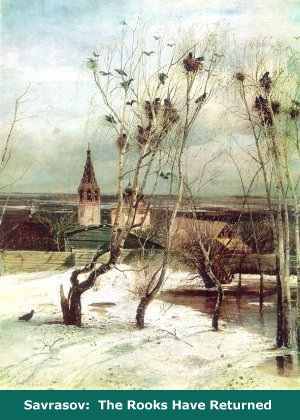
Task 6. Read this information and describe the landscape “Rooks Have Returned” (or “Rooks Are Back Again”) by A. Savrasov. Say whether you share this impression and in what way it can be enriched. Think of the continuation of this description.
Works by Alexey Savrasov, Ivan Shishkin , Vasiliy Polenov, Arkhip Kuinji, and Isaak Levitan were wildly received by the public. These masters showed the highest importance of ordinary motifs, scenes, and seasons of the year. Country sights were approached by artists much more often than urban motifs, thus emphasizing peasant themes. But it was not based purely on social problems. The whole gamut was captured on canvas. Green plain expanses, fallowed fields in the rain, endless travel-worn roads, narrow paths that stretched from different parts of the vast land, dense forests, impassable thickets, small lakes like blue saucers, hidden copses, and the beauty of the big Russian river Volga were all acceptable subjects for these Russian immortals.
The concept of nature, for Russian Itinerant artists has always been closely connected with a man being painted in his natural environment. Concerns about people and their thoughts and the Russian character were very much affected by landscape. The narrations about Russian nature indeed involved the telling of the life story of human beings living in nature.
One of the first among itinerant landscape artists was Alexey Savrasov. His painting, “ Rooks Are Back Again”, was exhibited for the first time at the exhibition of 1871 and it amazed the viewers. For the first time they saw a plain native landscape far removed from the flourishing Italian beauty typical of classical and romantic artists. A feeling of nature awakening after winter, trees with their bared branches standing in the distance, soft light coming from the blue sky, a bustle of the first birds, all combined to evoke a feeling of something dear to one's heart.... a familiar scene dating back to childhood. This sentimental landscape gained high significance in this genre.
Task 7. Explain the meaning of the words and give Russian equivalents.
to emphasize peasant themes
to capture the gamut
plain expanses
fallowed fields
travel-worn roads
vast land
impassable thickets
hidden copses
immortals
2.8. Ivan Ivanovich Shishkin (1832 – 1898)
Translation Practice
Шишкин Иван Иванович, русский живописец, один из крупнейших мастеров реалистической пейзажной живописи, член-учредитель Товарищества передвижных художественных выставок.
В начале своего творчества Шишкин следовал традициям романтического пейзажа (“Вид на острове Валааме”» 1858г.). В 60-е годы он преодолевает условность колорита и световых эффектов и обращается к возможно более объективному изображению русского лесного пейзажа, ставшего главной темой его творчества. Он переходит к созданию целостных образов русской природы, композиционными средствами раскрывая идею величия и красоты родной земли, своеобразия ее лесов и полей (“Рожь”, 1878; “Лесные дали”, 1884).
Постоянно работая над этюдами с натуры, Шишкин совершенствует светотеневое решение картин, добивается живописно-тонального единства, иногда обращаясь к мотивам изменчивого состояния природы (“Сосны, освещенные солнцем”, 1886). Он раскрывает типически-выразительные и поэтические черты русского ландшафта, вводя в пейзаж жанрово-повествовательные элементы (“Утро в сосновом лесу”, 1889; “Среди долины ровныя”, 1883). Шишкин создал монументальные и жизнеутверждающие образы родной природы, созвучные демократическим идеям исторического бытового и портретного жанра передвижников, а в лучших произведениях поднялся до широкого обобщения, воспевая национальный пейзаж героического характера (“Корабельная роща”, 1898). Реалистические пейзажи Шишкина, ставшие широко популярными, сыграли важную роль в борьбе за народный характер русской культуры в 1879-90-е годы (БСЭ, т.29, с.420).
Task 8. Read this description of I. Shishkin’s famous landscape “Rye”. Say whether you share this impression and in what way it can be enriched. Continue this description.
“Rye” is one of this artist’s best canvasses. By embellishing it, Shishkin transfigured the actual landscape that inspired the painting. Nevertheless, the painter remained faithful to reality and accurately depicted the details of the landscape: the flowers, trees and grain. The proportionate enlargement of details and the combination of various subjects - of the field and the forest, which in reality rarely coexist - create an epic image of an abundant Russian nature. There is rarely a place for man in epic landscapes; in this painting, the travellers walking along the road are barely visible in the ripe rye, which is in fact taller than it would be in reality. The powerful pines with dark green branches extend broadly like legendary heroes with mythic strength, uniting the blue of the sky and the gold of the rye to create a majestic portrait of Russian nature.
Ivan Shishkin in his works glorified the heroic spirit of the Russian land. He liked to emphasize the might and grandeur of Russian nature. Depicting mostly fields and forests, he was given an artistic name of "singer of fields and forests." His selfless love of nature made him not only an artist, but a botanist as well. He refused to be inaccurate depicting tree or blade. Numerous studies and sketches that survived till today offer testimony concerning his great care in studying nature.
Although Ivan Shishkin was often criticized for his naturalism and his unreasonable standards in his representation of nature, the careful work at the details of his paintings can't be called "naturalism." Naturalism in painting means blind imitation of a natural view without a well thought-out composition and without the correlation of common details and a particular selection of the items painted. At first sight, Shishkin's landscapes look so trustworthy that one can get the wrong impression of the artist's work. The artist desires the viewer to believe in the reality of such an existing view.
In this connection, his painting, “Rye”, is very typical. The artist selected the typical natural motives of a central Russian landscape: the field of rye, the road, and mighty oaks. Next he thought about the composition, trying to get the right correlation between the sky and the earth, the fore and background, as well as the right light combination. All these details create mighty images that affect the feelings of the viewer. In this painting the artist truly glorifies the true beauty and grandeur of Russian nature.
Notes
the might - мощь, могущество
abundant - изобильный, богатый
trustworthy - заслуживающий доверия, зд. достоверный, правдивый
grandeur – величие, великолепие, пышность
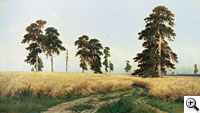
I.Shishkin: Rye (1878)
Task 9. Describe this Shishkin’s picture to your friend. Do not show it to him and do not tell him the picture’s name. Let your partner guess it. Use the information given below. (Look at its bigger copy in the Appendix)
Быть может, самая популярная картина Шишкина — “Утро в сосновом лесу”. В ней он стремится передать очарование нетронутой девственной природы, поэтизируя жизнь леса. Он передал характерное для него чувство восхищения жизнью первозданной природы, не тронутой столь часто губительным для нее вмешательством человека. В этой картине явственно ощутимы стремления мастера ко все более раскованному живописному языку, усиление внимания к передаче световоздушной среды, цветового богатства природы. Медведи написаны другом художника К.А. Савицким. Они получились столь удачно, что Савицкий даже расписался вместе с Шишкиным на картине. Однако П.М. Третьяков, купив картину, снял подпись. Он утвердил авторство одного Шишкина. Ведь в картине, говорил меценат, “начиная от замысла и кончая исполнением, все говорит о манере живописи, о творческом методе, свойственных именно Шишкину”.

Oil on canvas, 150 x 206 cm. Tretiakov Gallery, Moscow
2.9. Vasily Grigorievich Perov (1834 – 1882)
Vasily Perov got his education in the provincial Arzamass School of Art. During 1853 - 1861 Perov studied at the Moscow School of Painting, Sculpture, and Architecture. 1862 - 1864 He lived in Paris, studying art. After coming back Perov became a founding member in the Circle of the Itinerants. In 1886 Vasily Perov received a title of member of the Petersburg Academy of Arts.This Russian Artist is known for his genre scenes and portraits.
Perov depicted famous Russian writer Aleksander Ostrovsky, who exposed ignorant merchant class in his stories. This painting is considered to be one of the most significant portraits the artist painted.
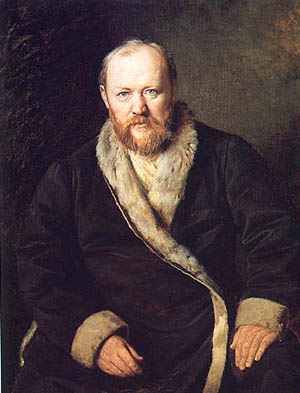 |
| V.Perov. Portrait of the Playwright A. N. Ostrovsky, Oil on canvas, 103.5 x 80.7 cm,1871,The State Tretyakov Gallery, Moscow |
Translation Practice
В начале 60-х гг. Перов создал ряд обличительных жанровых картин, подробно расказывая о несложных будничных событиях, усиливая и заостряя (вплоть до гротеска) социальные характеристики персонажей. Перов указывал на конкретных носителей общественного зла в крепостнической России (“Сельский крестный ход на пасхе”, 1861; “Чаепитие в Мытищах”, 1862). Работы парижского периода отмечены растущим интересом к человеческой индивидуальности, тягой к тональному колориту (“Слепой музыкант”, 1864). Во 2-ой половине 60-хгг. критические тенденции в творчестве Перова реализуются в произведениях, проникнутых сочувствием и состраданием к нищему, обездоленному люду. Картины становятся лаконичнее по композиции, выдерживаются в единой серовато-коричневой гамме. Большое значение в них приобретает пейзаж, получивший в его работах «социальный» характер и создающий общий эмоциональный строй произведения (“Проводы покойника”, 1865, “Тройка. Ученики мастеровые везут воду”, 1866 т.д.). Художник стремился также передать индивидуальные качества людей из народа, их способность глубогко мыслить и чувствовать. В 70-х- 80-х гг. Перов испытал идейный кризиз, в 1877 г. порвал с передвижниками, от обличительных жанровых тем он перешел преимущественно к бытоописательским «охотничьим» сценам (“Птицелов”, 1870; “Охотники на привале”, “Рыболов”, 1871).
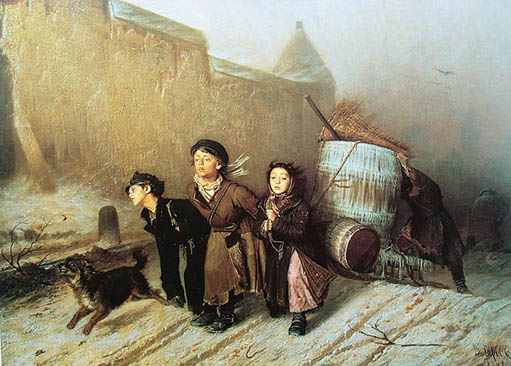
V. Perov. "The Troika", 1866
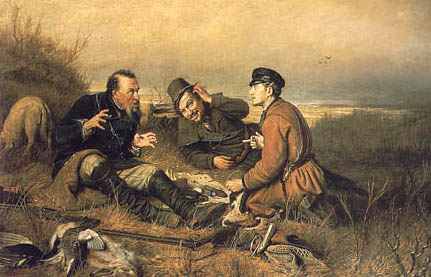
V. Perov. Hunters at rest.1871, Oil on canvas,
119 x 183 cm, Tretyakov Gallery
This painting is full of gentle humor and irony
2.10. Ivan Nikolaevich Kramskoi (1837 – 1887)
Ivan Nikolaevich Kramskoi attended the Petersburg Academy of Arts from 1857 to 1863, but he left before graduation because of the protest against the stagnant rules governing competitions there. Kramskoi became one of the creators and then a leader of the Petersburg Artel of Artists. He also was among the founders and participants in the Circle of the Itinerants. In 1869 Ivan Kramskoi received the title of an Academy member. The artist was an outstanding portraitist and had a great influence over Russian realist painting.
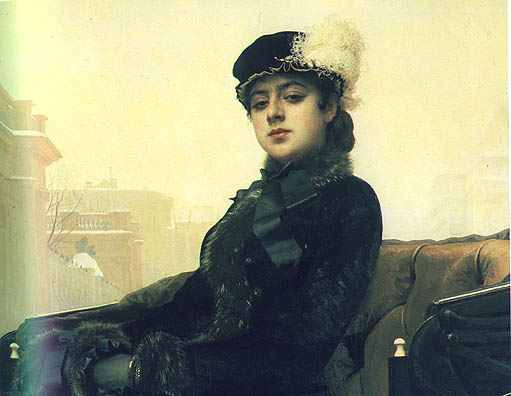
I. Kramskoi. Unknown Woman.1883. Oil on canvas. 75.5 x 99 cm
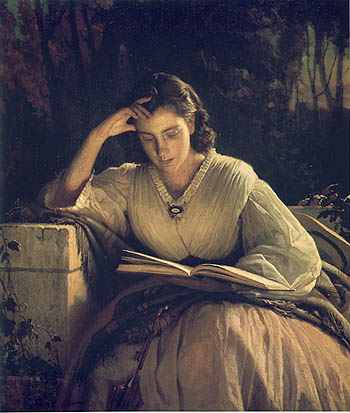
I. Kramskoi. Reading.The portrait of the Artist's wife, 1866-69,
Oil on canvas. Tretyakov Gallery.
2.11. Arkhip Ivanovich Kuindzhi (1841 – 1910)
Arkhip received no former training. He worked in I. Aivazovsky's studio in Feodosia (1865-66). Then attended Academy of Arts for a while. In 1878 he received a title of an Artist. Member of the Academy in 1893. Arkhip became a professor and head of the landscape studio at Higher Art School of the Academy in 1894-97.The Artist lived in the Crimea and St Petersburg. He was the founder of the society in his own name (1908) to which he donated substantial funds to support Russian artists and left his paintings to it. Kuindzhi was a member of Traveling Art Exhibits but he also showed his works independently - especially in 1880, showing his famous Moonlight on the Dniepr.
In later work, Kuindzhi searched for new, expressive ways of depicting nature. After stopping participating in exhibitions and closing his studio for visitors, he devoted himself to experimentation.
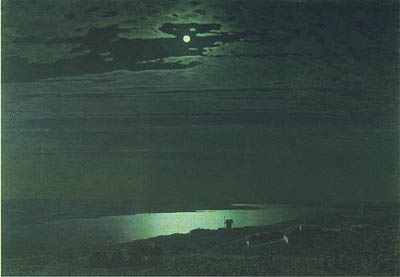 |
| A. Kuindzhi. Moonlit Night on the Dnieper, 1880. Oil on canvas.105x144cm. Russian Museum |
Translation Practice
Архип Ивановия Куинджи русский живописец-пейзажист. Сын сапожника-грека. Живописи обучался главным образом самостоятельно и в петербургской Академии Художеств (1868). Член товарищества передвижных художественных выставок. В ранний период испытывал влияние И.К.Айвазовского. В середине 1870-х гг. создал ряд картин, в которых пейзажный мотив рассчитан на конкретные социальные ассоциации в духе передвижников (“Забытая деревня”, 1874, “Чумацкий тракт”, 1875). В произведениях зрелого периода Кунджи стремился передать наиболее выразительные по освещению состояния природы. Используя световые эффекты и интенсивные цвета, сведенные к нескольким главным тонам, он добивался почти полной иллюзии освещения (“Украинская ночь”, 1876; “Березовая роща”, 1879; “После грозы”, 1879; “Ночь на Днепре”, 1880).
2.12. Ilya Efimovich Repin (1844 – 1830)
The creative heritage of Ilya Repin plays a special role in genre painting and in Russian art as a whole. He is considered to be the most talented and famous Russian painter. His interests in painting were pointed mainly to contemporary subjects. He was interested in all aspects of Russian reality, but his talent was more fully revealed in genre and portrait painting. His works can be considered as an encyclopedia of Russian life with its heroes and events. His first famous painting, “Barge Haulers on the Volga”, painted while he was a student of the Academy of Fine Arts, showed his talent and characteristic manner of work. Unlike the artists who had treated this subject before, Repin was much more interested in the participants of the scene. He wanted the viewers to see their fates and personalities more than the hard labor they were forced to perform. He was the first in the history of art who tried to peer into people's faces to understand who they were. For the first time a common Russian man was depicted as a hero of artistic work. He didn't idealize his heroes but tried to demonstrate their personality. For the first time people could see a group portrait of miserable and humiliated Russian people. The artist's aspiration to concentrate attention on the psychology of people was always Repin's characteristic feature.
Notes
to treat smth - иметь дело с ч-л; рассматривать ч-л
to peer into people's faces - всматриваться в лица людей
artist's aspiration - стремление художника
to haul - тянуть, волочить
barge haulers = bargemen - бурлаки
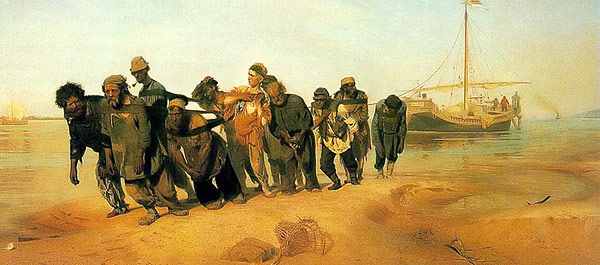
I. Repin. Barge Haulers on the Volga
The action in “ Religious Procession in Kursk Province” by Repin takes place in a province famous for its dense forests, but in the picture we can see only stumps left after the trees had been cut down. Modern man's activity resulted in the destruction of nature. We see crowds of people marching along the dusty road.
The composition was arranged in such a way that we almost feel the crowd moving forward, about to crush the spectator. Real religious faith can be read on the faces of heroes depicted on the left of the canvas and especially in the face of the hunchback on the foreground. Note that he is pushed aside by the policeman riding a horse because this poor cripple might disturb rich people proceeding along the road. (Didn't Christ say we are all equal before him?) The painting shows us two extremes: superficial, cold, hypocritical religious feelings on the right half and true believers in God in the left half of the painting. These people are rejected by this insincere society on the left part of the painting. By paying such attention to the individuality of a person, Repin displays the great variety of types and characters of his heroes. In the foreground we see a rich merchant woman avidly holding a icon. She is drawn into arrogance, clearly breaking the main tenet of Christianity. We can spend hours examining the painting whereby the motley crowd is represented as an integral part of the Russian people.
Notes
stumps - пень
to result in - приводить к чему-либо
to crush the spectator - давить на зрителя, раздавливать…
faith - вера
on the left (right) of the canvas - слева (справа) на полотне
in the left half of the painting - в левой половине катрины
hunchback - горбун
on the foreground – на переднем плане
cripple - калека, инвалид
superficial - поверхностный, неглубокий
hypocritical - лицемерный, притворный, ханжеский
true believers – истинные верующие
avidly - жадно, алчно
arrogance - высокомерие, надменость
a main tenet of Christianity - главный принцип Христианства
tenet - догмат, принцип, доктрина
whereby - посредством чего
the motley crowd - пестрая толпа
Task 10. Learn this description by heart.
“They Did Not Expect Him” (1884-1888), one of Repin's best known works, is considered by critics "the finest artistic achievement of the social point of view of the Peredvizhniki. The painting shows a family surprised by an unexpected return of a political exile home. In the first version of the painting, the exile was a female; in the final version it is a male, a son, a husband, and a father at the same time. To create his composition, Repin used his home and the members of his family as models. Each person in the painting has a different facial expression, captured very dramatically by the artist. The exiled man, clutching his hat, hesitates in the middle of the room, but instantly recognizes his mother. The old woman rises from her armchair, and her figure projects a surprise and weakness at the same time. In the back, at the piano, is the man's wife. Perhaps she is not certain who has just entered the room; she smiles, but does not try to run to embrace her husband. The little girl at the table looks at the figure suspiciously - she does not know who it is because she is too young to remember her father. But the boy sitting next to her recognizes him instantly and his face is beaming. Two other figures, t
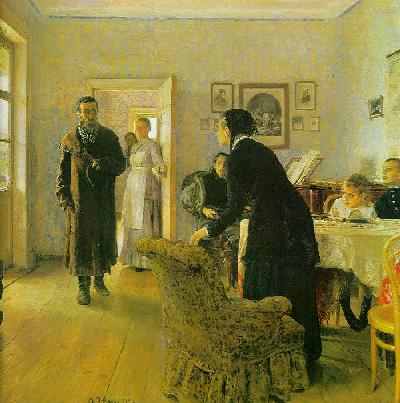 he maid at the door and the cook behind her, also express their feelings. The cook is simply curious - she wants to discover who the man is and what is going to happen next. The maid is still holding the door knob and her face is simultaneously polite (she is performing her duties) and astonished.
he maid at the door and the cook behind her, also express their feelings. The cook is simply curious - she wants to discover who the man is and what is going to happen next. The maid is still holding the door knob and her face is simultaneously polite (she is performing her duties) and astonished.The composition can be divided into several planes: the farthest is the kitchen window, followed by the figures of the cook and the maid. The third plane includes the wall of the living room and the woman at the piano. The fourth, most important plane encompasses the figure of the man and the table with his children. The foreground is occupied by the figure of the mother and her armchair. Notice, however, how cleverly Repin places these two elements off center, allowing the viewer's eyes to follow the direction of the floorboards and see the exiled man immediately. Commenting on the composition, Hamilton suggests that the "right-to-left direction in space, opposed by the sharpened perspective drawing of the floorboards, is so suggestive of Degas that we can believe that the lessons learned in Paris ten years before had at last come to fruition" . The picture is full of light, which, despite the seriousness of the topic and the work's obvious political overtones, makes this scene joyous (the viewer can easily imagine that in a moment the room will be filled with cries of joy, laughter, tears of happiness, and celebrations of the return).
2.13. Vasily Ivanovich Surikov (1848 – 1916)
